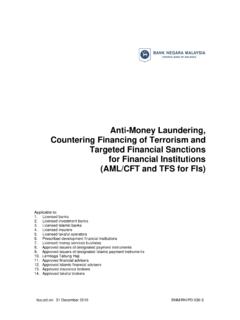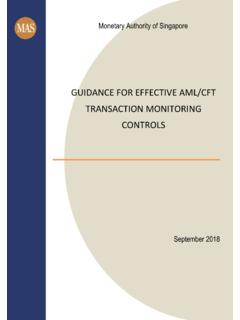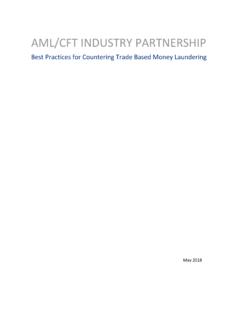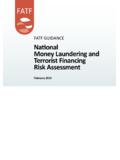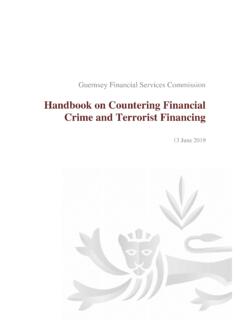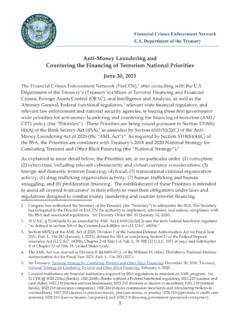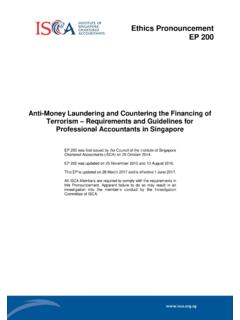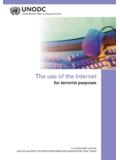Transcription of Emerging Terrorist Financing Risks - FATF-GAFI.ORG
1 FATF REPORTE merging Terrorist Financing RisksOctober 2015 The Financial Action Task Force (FATF) is an independent inter-governmental body that develops and promotes policies to protect the global financial system against money laundering, Terrorist Financing and the Financing of proliferation of weapons of mass destruction. The FATF Recommendations are recognised as the global anti-money laundering (AML) and counter- Terrorist Financing (CFT) standard. For more information about the FATF, please visit This document and/or any map included herein are without prejudice to the status of or sovereignty over any territory, to the delimitation of international frontiers and boundaries and to the name of any territory, city or area.
2 Citing reference: FATF (2015), Emerging Terrorist Financing Risks , FATF, Paris 2015 FATF/OECD. All rights reserved. No reproduction or translation of this publication may be made without prior written permission. Applications for such permission, for all or part of this publication, should be made to the FATF Secretariat, 2 rue Andr Pascal 75775 Paris Cedex 16, France (fax: +33 1 44 30 61 37 or e-mail: Photocredits coverphoto: Thinkstock Emerging Terrorist Financing Risks 2015 1 TABLE OF CONTENTS ACRONYMS .. 3 EXECUTIVE SUMMARY .. 5 I. INTRODUCTION .. 7 Purpose, scope and objectives .. 7 Methodology, participants and data utilised .. 7 Terminology .. 8 II. FINANCIAL MANAGEMENT OF Terrorist ORGANISATIONS .. 9 A. Use of funds .. 9 Terrorist organisations.)
3 9 Lone actors and small Terrorist cells .. 10 B. Managing resources .. 11 C. Conclusions and financial management .. 12 III. TRADITIONAL Terrorist Financing METHODS AND TECHNIQUES .. 13 A. Generating revenue .. 13 Private donations .. 13 Abuse and misuse of non-profit organisations .. 14 Proceeds of criminal activity .. 15 Extorting local and diaspora populations and businesses .. 17 Kidnapping for ransom .. 18 Legitimate commercial enterprise .. 19 State sponsorship of terrorism .. 20 B. Movement of funds .. 20 Funds transfers through banks .. 20 Money value transfer systems .. 21 Physical transportation of cash .. 23 C. Conclusions on traditional TF methods and techniques .. 23 IV. Emerging Terrorist Financing THREATS AND VULNERABILITIES .. 24 A. Foreign Terrorist fighters (FTFs).
4 24 Funding needs of FTFs .. 24 Self-Funding .. 25 FTF recruitment/facilitation 28 Movement of funds associated with FTFs .. 29 Challenges associated with combating FTFs .. 30 B. Fundraising through social media .. 30 Challenges associated with the use of social media .. 34 C. New payment products and services .. 35 Virtual currencies .. 35 Prepaid cards .. 36 Internet-based payment services .. 37 Challenges associated with new payment products and services .. 39 Emerging Terrorist Financing Risks 2 2015 D. Exploitation of natural resources .. 39 Oil and gas sector .. 39 Mining sector .. 41 Challenges associated with exploitation of natural resources .. 42 OVERALL CONCLUSIONS .. 43 BIBLIOGRAPHY AND REFERENCES .. 45 Emerging Terrorist Financing Risks 2015 3 ACRONYMS AML Anti-money laundering CFT countering the Financing of terrorism CIFG Counter ISIL Financing Group ESAMLG Eastern and Southern Africa Anti-Money Laundering Group FIU Financial intelligence unit FTF Foreign Terrorist fighter GAFILAT Financial Action Task Force of Latin America ISIL Islamic State of Iraq and Levant MSB Money service business MVTS Money value transfer services NPO Non-profit organisation TF Terrorist Financing UN United Nations Emerging Terrorist Financing Risks 2015 5 EXECUTIVE SUMMARY While the number and type of Terrorist groups and related threats have changed over time, the basic need for terrorists to raise, move and use funds has remained the same.
5 However, as the size, scope and structure of Terrorist organisations have evolved, so too have their methods to raise and manage funds. The main objective of this report is to analyse recently identified Terrorist Financing (TF) methods and phenomena, referred to as Emerging TF Risks . This report highlights that understanding how a Terrorist organisation manages its assets is critical to starving the organisation of funds and disrupting their activities in the long term. Terrorist organisations have different needs, depending on whether they are large, small, or simply constituted of a network of seemingly isolated individuals. The section on financial management explores the use of funds by Terrorist organisations, not only for operational needs but also for propaganda, recruitment and training, and the techniques used to manage these funds, including allocating specialised financial roles.
6 The report finds that authorities need to do further work to identify and target various entities responsible for these functions. In assessing the continued relevance of traditional TF techniques (that is, those techniques identified in the FATF Terrorist Financing Typologies Report (FATF, 2008)) the general conclusion is that while all these techniques are evolving, they still represent significant TF Risks . Jurisdictions provided a range of case studies to demonstrate the ongoing threats and vulnerabilities. Jurisdictions national risk assessments were particularly useful in this analysis. Anti-money laundering (AML) and countering the Financing of terrorism (CFT) systems and operational measures have made it more difficult for Terrorist organisations to use traditional avenues to raise or move funds.
7 However, the adaptability of these organisations, and new threats posed by foreign Terrorist fighters and small cell terror networks, require authorities to monitor how these traditional methods continue to be used. The use of national risk assessments to conduct strategic analysis of current TF Risks will help inform policy makers to implement the necessary legal and operational measures. With respect to the section on Emerging TF Risks , the FATF decided to explore the threats and vulnerabilities posed by: 1. foreign Terrorist fighters (FTFs), 2. fundraising through social media, 3. new payment products and services, and 4. the exploitation of natural resources. The FTF phenomenon is not new, but the recent scaling up of individuals travelling to Iraq and Syria has been a challenge for many FATF members.
8 FTFs are predominantly using traditional methods, particularly self-funding, to raise the funds they require to travel to the conflict areas. However, the novel aspect for jurisdictions is the challenge in identifying these individuals because of the relatively low amounts of funding they require and the speed with which they can acquire it. The report reveals that financial intelligence can assist in identifying FTFs in a number of ways. Close cooperation between authorities domestically and internationally and close Emerging Terrorist Financing Risks 6 2015 partnerships between authorities and the private sector can assist to better identify FTFs and their facilitation networks. The report also shows that further work is required to shed light on blind spots in information about FTFs, including returnees.
9 The role of social media in breeding violent extremism has been well reported but less is known about how it used to raise funds for terrorists and Terrorist groups. The report finds that there are significant vulnerabilities associated with social media, including anonymity, access to a wider range and number of potential sponsors or sympathisers and the relative ease with which it integrates electronic payment mechanisms. It is also apparent that donors are often unaware of the end-use of funds supported by social media, including crowdfunding, which presents a risk that Terrorist organisations can exploit. This report finds that electronic, on-line and new payment methods pose an Emerging terrorism Financing vulnerability which may increase over the short term as the overall use and popularity of these systems grows.
10 Many of these systems can be accessed globally and used to transfer funds quickly. While transactions may be traceable, it proves difficult to identify the actual end-user or beneficiary. This report presents a number of interesting cases, but the actual prevalence and level of exploitation of these technologies by Terrorist groups and their supporters is not clear at this time and remains an ongoing information gap to be explored. The exploitation of natural resources for TF was raised as a substantial concern in the context of the Islamic State of Iraq and the Levant (ISIL) but this report has confirmed that it is also relevant for other Terrorist organisations and regions. The ability to reap high rewards from the natural resources sector, coupled with the weak institutional capability, particular in or near areas of conflict, creates a significant vulnerability for Terrorist organisations to capitalise on.










